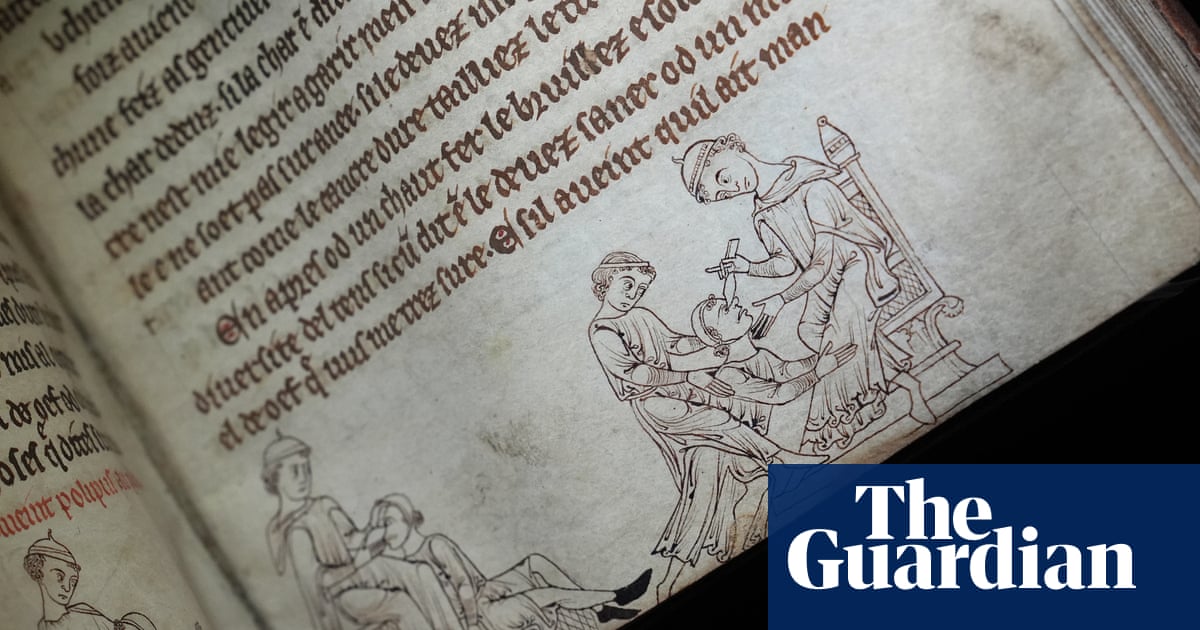Medieval treatments might make you question the sanity of the doctors of the day, but a new exhibition is set to take visitors inside the minds of such medics and reveal the method behind what can seem like madness.
Curious Cures, opening on Saturday at Cambridge University Library, is the culmination of a project to digitise and catalogue more than 180 manuscripts, mostly dating from the 14th or 15th centuries, that contain recipes for medical treatments, from compendiums of cures to alchemical texts and guides to healthy living.
Among the items on display are wince-inducing surgical diagrams, illustrations such as Zodiac Man – which depicts different body parts associated with star signs – and the recipes themselves, together with translations.
What is clear is that while people from the middle ages faced many of the same ailments experienced by patients today, they tackled them rather differently.
One of the manuscripts on show, dating from the 15th century, suggests women can cure their infertility by burning weasel testicles in a pot with mouse-ear – a type of chickweed – to create pessaries that are placed in the cervix for three days.
“After these three days however, she should have intercourse with a man and she should conceive without delay,” the manuscript states.
Another recipe suggests curing lice using a mixture of mercury and roasted apples.
Yet, while some of the remedies might seem alarming to modern eyes, Dr James Freeman, the curator of the exhibition, said it was a misconception to view medieval medicine as based on blind trial and error, or total superstition.
“Medieval people thought about things,” he said. “They are intelligent, rational, curious and intensely interested in trying to understand how the body functions and what caused and what could cure disease.”
In an attempt to help visitors get inside the mind of medieval medics, the exhibition explores how people of the time thought the body worked, including the idea of the four humours that was developed by the Roman doctor Galen.
“Actually, there was a very elaborate and sophisticated system of thought within which medical practitioners operated,” said Freeman, adding that while the use of animal parts might seem strange and improbable, it needed to be seen in context.
“Medieval people were living in a world in which creation had been designed by God and all of the plants and animals placed within it for the benefit of man,” he said, adding there was also a “sympathetic” medical idea that things that correspond with parts of the human body would therefore be beneficial for them.
“Hence, I suspect, the weasel testicles being used as part of a remedy for infertility,” Freeman said.
However, Freeman noted that many of the recipes do not give a source or rationale, with some – such as the apple and mercury cure for lice – apparently based on personal experience or hearsay.
The exhibition also explores the role of astrology and even magic in medieval medicine, and sheds light on how people of the time viewed death. Among the exhibits is a brass rubbing of a plaque commissioned by the Oxford academic Sir Ralph Hamsterley, before he died in 1518, depicting his shrouded skeleton riddled with worms and requesting prayers for his soul.
The range of medical practitioners is also covered, revealing that, as well as educated physicians, members of religious orders, barbers, apothecaries and common healers treated patients, with women among those known to practise medicine.
Yet, Freeman said his work on the exhibition had yet to inspire him to try any medieval remedies himself.
“It made me glad to be alive in the 21st century, for all our current problems,” he said.







